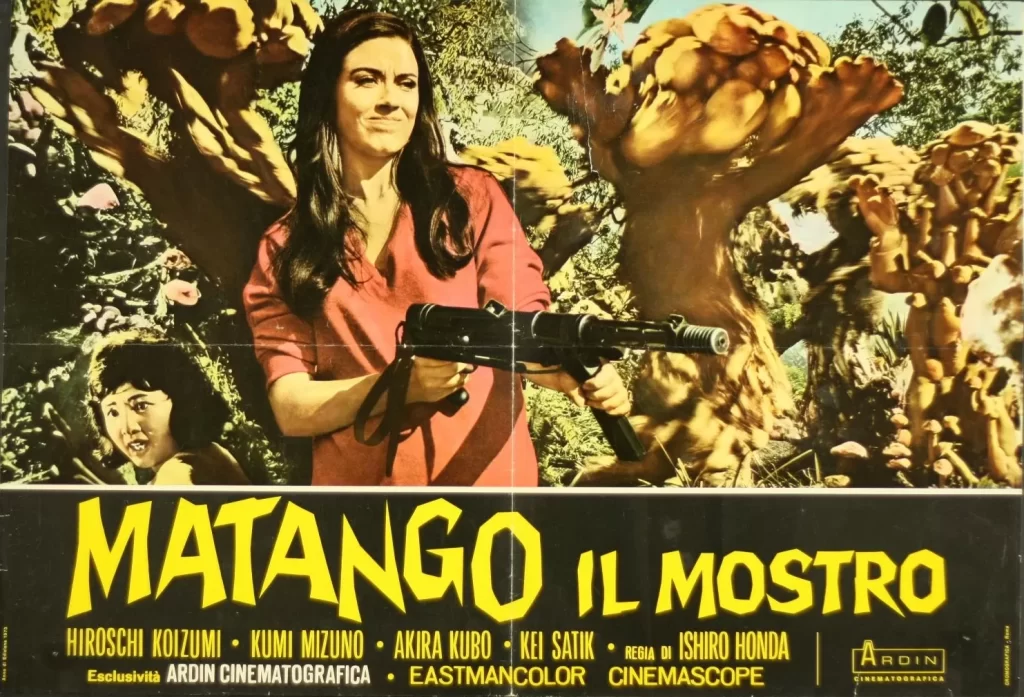While Ishiro Honda is primarily known in the West for kaiju films like Godzilla, Rodan, and Mothra (and with good reason, as they’re some of the most distinctive monster movies around) his filmography also boasts examples of monsters that aren’t so gigantic. Two of them – 1958’s The H-Man and 1960’s The Human Vapor – are about men transformed into monsters by scientific means. A third, 1963’s Matango, earns its spot in the Criterion Channel’s new “Body Horror” program thanks to the horrific nature of the slowly developing mutations in it. If Godzilla represents Japan’s nuclear anxiety writ large, then Matango is the same, only on a human scale, which renders it all the more disturbing.
The premise is breathtaking in its simplicity: What if, instead of being stranded on a desert island with abundant resources, the castaways of Gilligan’s Island washed up on one with plenty of vegetation, but little that’s edible, and next to no animal life? Oh, and there’s a rare mushroom that causes whoever consumes it to slowly become fungi themselves. While this would have been played for laughs if it happened to Gilligan and company – and likely would have worn off by the end of the episode – it’s horrifying when it happens here.
Incidentally, the Gilligan’s Island comparison isn’t entirely facetious. Not only does Matango start with a yachting excursion that goes south when the weather gets rough, but in addition to the skipper and his mate, there’s also a millionaire and his mistress (a singing star), and a college professor and his Mary Ann-like companion. The odd one out, then, is a mystery writer whose active imagination comes into play when the castaways find another shipwrecked boat, but no sign of its crew.
“No one should be here. Only dead bodies or skulls.”
The ominous music at the top of the film sets the tone as Honda’s frequent cinematographer Hajime Koizumi pans across the Tokyo skyline at night, as viewed from a hospital room. Its occupant, Kenji Murai (Akira Kubo), is in shadow and keeps his back to the camera as he begins to spin the story of how he came to be there. The score abruptly switches from brooding to jaunty as we transition to the pleasure cruise in happier times, sketching in the relationships and responsibilities of the seven on board. There’s even time for a song by Mami Sekiguchi (Kumi Mizuno), who says she’s only with millionaire Kasai (Yoshio Tsuchiya) because he’s promised to take her to Europe. That’s off the itinerary, though, when a violent storm destroys Kasai’s 40 million yen yacht, which winds up adrift in the fog. That’s also the occasion for the first hallucination, when writer Yoshida (Hiroshi Tachikawa) sees a ship bearing down on them, but that turns out to be a ghostly premonition of the danger to come.
Tempers are already wearing thin when land is sighted, and the passengers begin the desperate search for sustenance while skipper Sakuta (Hiroshi Koizumi) tries to make the yacht seaworthy. This follows the discovery of the other wreck, which turns out to be an ocean investigation ship for nuclear explosions. Not only is there mold on every surface, but its records state that Matango, the giant mushroom found on the island, has “a drug-like effect, disabling the nerves.” Even the discovery of canned food in the hold becomes a source of tension as they squabble over how to ration it. Then again, it doesn’t help that Koyama (Kenji Sahara), the sailor who finds it, is less than eager to share with the others.
“Humans will turn into animals, depending on the environment.”
All the while, there are signs that stranger things are afoot, beginning with a glimpse of a mushroom creature on the move, followed closely by a nocturnal visit from the mutant existing between states. As the days drag on, hunger leads to delirium, and sexual frustration leads to the breakdown of decorum. After two of the men fight over her, Mami boasts to the demure Akiko (Miki Yashiro) that “Everybody wants me.” Sisterly solidarity is the last thing on her mind.
Everything comes to a mushroom head when the characters break down and start eating Matango. As they shed their humanity and embrace a hedonistic existence, Honda pulls out all the stops, turning up the psychedelic imagery and nightmare fuel as Kasai is led straight into Matango’s domain and Murai attempts to rescue Akiko from it. Aided by special effects director Eiji Tsubaraya and his team, Honda makes good on the film’s American title, Attack of the Mushroom People, while making sure the viewer is acutely aware man’s worst enemy continues to be his fellow man. Half a decade later, when Toho’s rival Shochiku threw its hat into the body horror ring with 1968’s Goke, Bodysnatcher from Hell, that lesson was taken as a given.
“Matango” is streaming on the Criterion Channel as part of its “Body Horror” program.

